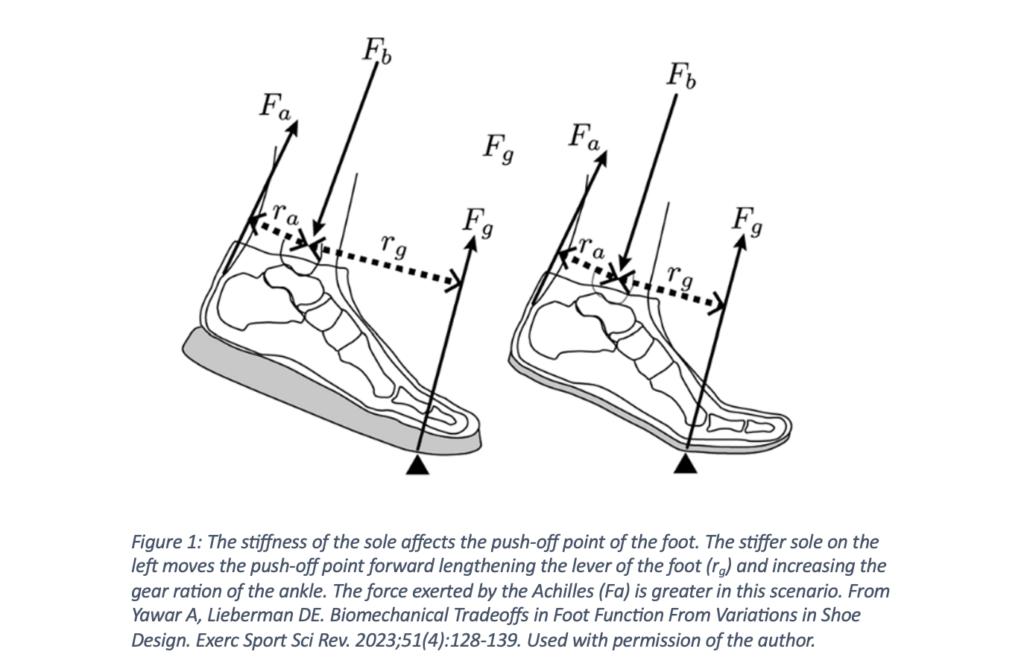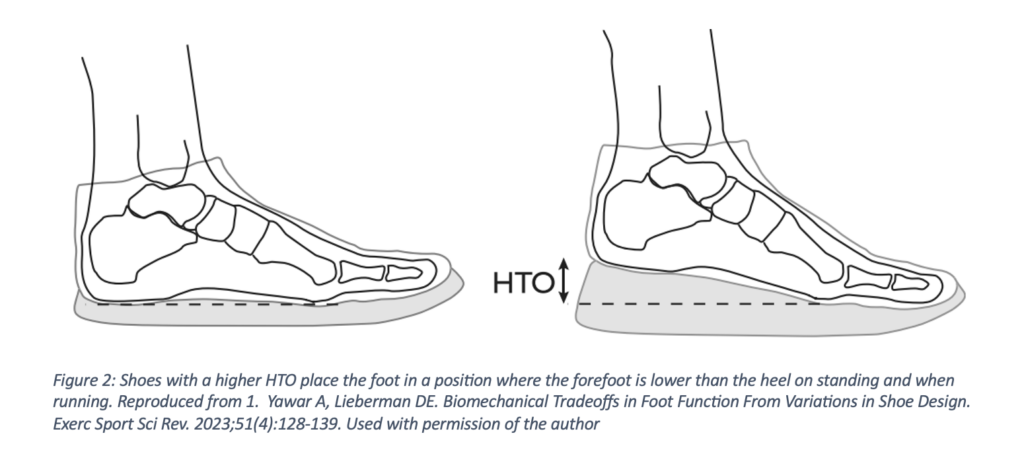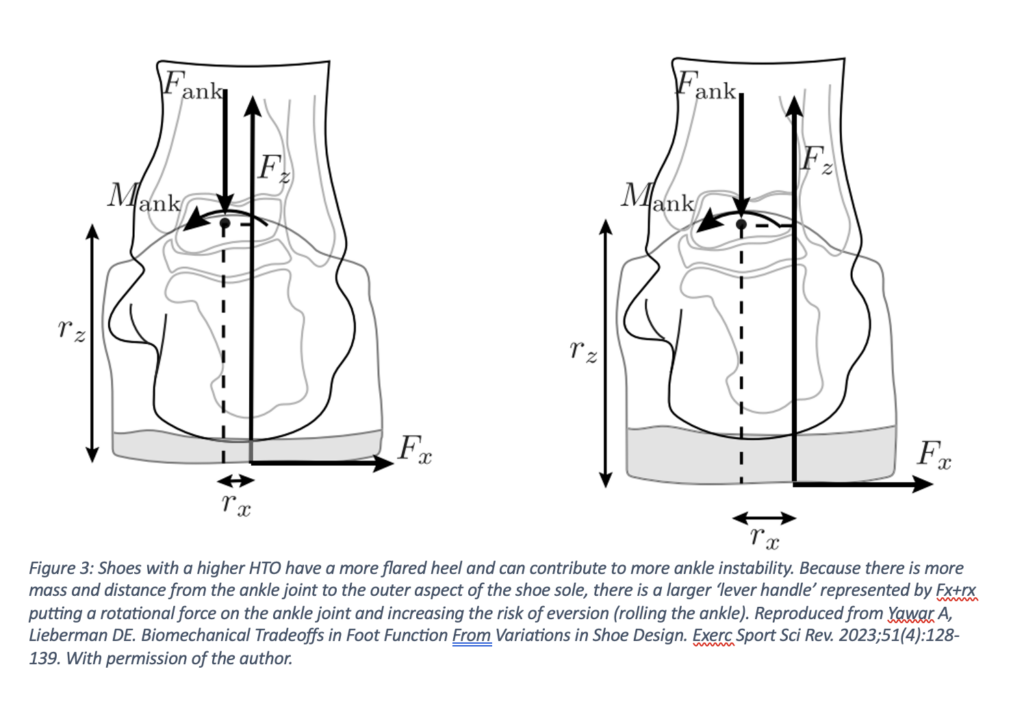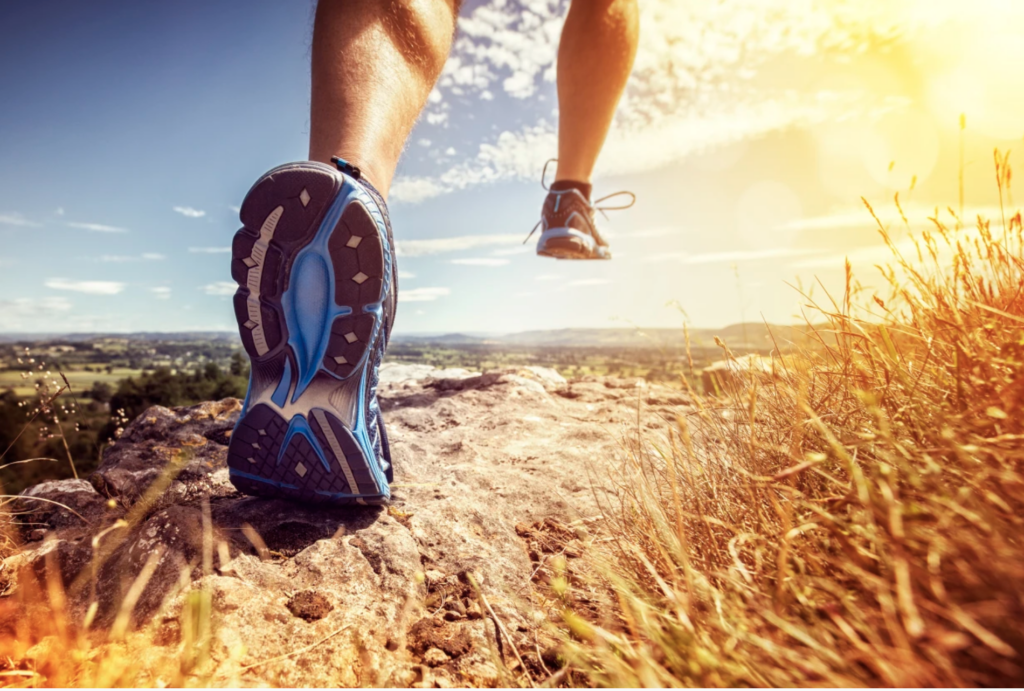by Coach Jeff Sankoff, M.D.
Running Shoes and The Biomechanical Tradeoffs They Bring to Runners: Risks and Benefits?
Human beings have been walking upright for millions of years and beginning approximately two million years ago even began running long distances. Given that the first evidence of simple footwear dates to only around 40,000 years ago that means that for most of our species’ time on this planet we have run barefoot.
In some parts of the world, barefoot running is still the preferred means of locomotion and it is clear that our feet are very well adapted for this purpose. However, in our built world with its unforgiving concrete surfaces we no longer spend as much time on our feet as our ancestors did and those of us who do run tend to do so for very different reasons and for very different amount of times than they did as well. Because of all this, we have adopted the use of specialized running shoes to help us navigate an environment that is much more hostile to our feet than the ancient plains were. Shoes also help us avoid injury since our feet, though evolutionarily unchanged, are less prepared to handle the stress of running in the way that we do now.
Since the 1970’s when manufacturers began to develop shoes with both performance and injury prevention in mind, running shoes have taken a diverse array of designs. From high cushioned heels with embedded carbon plates and highly elastic foams in the sole to minimalist shoes with almost no cushioning and extremely supple footbeds with every variation imaginable in between.
The variety in shoe design is matched by the innumerable opinions about whether any of them actually benefit injury prevention or to a lesser degree performance. What is not in dispute, is the idea that each of the design choices that shoe manufacturers make bring with it benefits at the expense of certain tradeoffs related to alterations in the biomechanics of the feet, ankles and knees each of which carry with them potential pitfalls.
A recent article in the journal Exercise and Sport Sciences Reviews from Harvard University evolutionary biologists Ali Yawar and Daniel Lieberman examines these tradeoffs in detail.[i] This is not done in an effort to suggest that somehow today’s cushioned shoes are bad. Rather, they merely point out that humans evolved to be able to run efficiently and that engineered shoes offer benefits that often bring with them unintended consequences.
Today’s high tech running shoes feature more than twenty different independent design features but six of them are believed to be the most important in terms of their biomechanical effects and the paper goes into detail explaining each of them.
- Shoe mass
When running, the metabolic cost attributable to swinging the leg forward from the take-off position to the landing position for the next step is significant. Estimates are that up to 20% of the metabolic cost of running is for this activity alone. The reason for this has to do with the size of the feet that average about 9% of the total mass of the leg.
Foot mass has a significant impact on running economy with every 100g added being shown to increase the metabolic cost by 1%. With larger, more cushioned shoes there is an appreciable increase in mass to the foot and a resultant increase in the metabolic needs for running. However, and here is where the biomechanical tradeoffs come in, the authors argue that because the cushioning in the sole may act to help a runner save energy in other ways and provide kinetic tradeoffs that will improve speed there is a net benefit to increasing the mass of the shoe.
- Compressive stiffness of the sole
As sole thickness increases so too does the compressive stiffness. This physical property has a direct effect on how ground forces are absorbed by the foot and the leg when running.
Early on when running became very popular and running injuries began to increase in a commensurate fashion, those injuries were theorized to be a direct result of the repetitive force of impact of the foot against the ground. By providing cushioning in the form of a thick and minimally compressive sole manufacturers hypothesized, injuries could be reduced because the collision force would be absorbed by the shoe itself instead of the structures of the foot and leg.
There is some evidence to show that this does happen. Thicker soled, softer shoes do indeed slow the rate of impact with the ground allowing for the force to be dissipated more gradually than is the case when running barefoot. However, just like with shoe mass, there is an important tradeoff here as well that must be considered and helps explain why cushioning alone does not simply obviate all impact related running injuries.
The key tradeoff here is that with a thicker soled, softer shoe, the rate of impact with the ground is slowed but the duration of the impact lasts longer and so while the maximal force is lower than without cushioning the total impact force is greater because it lasts for longer. This is referred to as the impact impulse.
This tradeoff is variable across runners with different gaits. Those who run with a heel strike are affected most while those who run with a forefoot landing see a decrease in impact impulse when wearing cushioned shoes.
- Sole bending stiffness
The stiffer the sole of the shoe, the more resistant it becomes to bending. With decreased bending, the push off point for the foot moves forward and there is more strain placed on the Achilles tendon to lever this longer platform around the ankle joint in order to propel the body forward (see figure 1). The result of this shift in push off point is to create a bigger gear ratio for the ankle joint and allow for increased speed of propulsion.
However, there is a tradeoff for the creation of this larger gear. In a study that evaluated runners using shoes with differing sole stiffness, researchers found that the metabolic cost associated

with running in stiffer shoes was increased though there was a relationship to running speed. Running at higher speeds reduced metabolic costs while running at lower speeds increased those costs. This has important relevance for the use of shoes with carbon fiber plates embedded in the soles. Those plates add significant stiffness to the sole of the shoe and this research would suggest that slower runners may be paying a penalty for using them in the form of a higher metabolic cost than if they used a softer soled shoe.
- Arch support
The arches of our feet evolved over millennia to serve an important purpose related to running. The medial longitudinal arch (MLA) and the transverse tarsal arch (TTA) together stiffen the foot making it resistant to deforming upon landing and the former functions as a spring, storing energy on landing and then releasing it as we take off. Arch supports consist of stiff materials in the sole of the shoe underneath the two arches minimizing or preventing them from deforming.
Arch supports result in yet another important tradeoff; by reducing the deformation of the MLA, the plantar fascia and small intrinsic muscles of the foot are protected from strain but this comes at the cost of potentially developing weakness in those structures and increasing risk of injury (arch supports can be used in situations when the plantar fascia has already been injured as this may confer protection from further injury to some degree). Furthermore, arch support compromises the natural spring function of the MLA reducing running economy. In some studies the cost has been measured to be as much as 6%.
- Larger heel-to-toe offset (HTO).
A thicker heeled shoe results in a larger drop to the forefoot. This is called the heel-to-toe offset (HTO). As described earlier, a thicker heel results in a reduced rate of loading to the foot and ankle but with a higher overall impact impulse. However, HTO has other consequences to biomechanics because of the way it causes the foot to be in a plantar flexed position on standing and on striking the ground (see figure 2). This reduces how much force can be generated by the ankle, previously noted as an important component of generating running velocity, and often results in longer stride lengths and changes in the biomechanical interactions of the joints of the lower leg because of the change in position of the foot and ankle upon landing.

Shoes with higher HTO also have wider flare of the sole out from the heel ostensibly to provide more stability for the runner. Unfortunately, these flared heels actually increase the likelihood of eversion of the ankle (rolling the ankle) because of the fact that the flared sole allows for a larger lever that can exert a rotational force on the ankle joint with each step (see figure 3).

Figure 3: Shoes with a higher HTO have a more flared heel and can contribute to more ankle instability. Because there is more mass and distance from the ankle joint to the outer aspect of the shoe sole, there is a larger ‘lever handle’ represented by Fx+rx putting a rotational force on the ankle joint and increasing the risk of eversion (rolling the ankle). Reproduced from Yawar A, Lieberman DE. Biomechanical Tradeoffs in Foot Function From Variations in Shoe Design. Exerc Sport Sci Rev. 2023;51(4):128-139. With permission of the author.
- Increased sole thickness and decreased proprioception.
The final characteristic of shoe development that carries with it important tradeoffs is the thickness of the sole of the shoe and how that alters our ability to sense the terrain upon which we are walking or running. Our feet are imbued with an incredibly rich network of sensory receptors to allow us to receive feedback about the ground we are walking upon and also in order to be able to remain upright. With thicker and softer soles, this sensory feedback is lost and there may be an increased risk of falling. One author showed that regardless of age, softer soled shoes were associated with more difficulty keeping balance.
The rapid and diverse development of running shoes over the past several decades has resulted in several important biomechanical tradeoffs to provide today’s runners with better protection, injury prevention and comfort. None of these tradeoffs should be viewed as a means of making an argument that running barefoot is preferred to running with highly engineered shoes. Instead, we should view these as they are intended, as insights to how shoes and runners interact and to help us understand how to better select for features that can improve an individual’s ability to run comfortably and more likely remain injury free.
Of all the shoe design features listed and examined by Yawar and Lieberman, sole thickness is the one that is associated with the most important tradeoffs because it relates so intimately to several other features such as shoe mass, sole stiffness, heel height and arch support. As more and more triathletes adopt so-called super shoes, those with special foams and carbon fiber plates embedded in the soles, the potential costs of these shoes must be measured against the advertised benefits. Triathletes need to be honest about what type of runner they are and what they want from their shoes, comfort, injury prevention or performance.
Keeping in mind the very real metabolic costs of some of these features, runners may be better suited to choose a shoe that matches their running style and performance rather than looking for a shoe that they believe will transform them into something they are not.
Train hard, train healthy.
[i] Yawar A, Lieberman DE. Biomechanical Tradeoffs in Foot Function From Variations in Shoe Design. Exerc Sport Sci Rev. 2023;51(4):128-139. doi:10.1249/JES.0000000000000322
